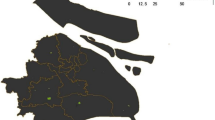Abstract
Brownfield redevelopment is a new urban land use strategy to pursue the ideal of sustainable development. It relieves environmental pressure and resolves the glaring contradiction between urban land idleness and urban sprawl. It addresses issues of urban land use and farmland protection in China. This paper compares brownfield with greenfield, and defines brownfield and its redevelopment. It elaborates general and special government policies for this sustainable land use strategy in the context of China. General policies contain two aspects: clarifying brownfield redevelopment’s priority in Chinese urban planning and land use and setting a general quantitative redevelopment target. The extent of the government’s special policies, which aim at coordinating three factors in the redevelopment process, namely governments, developers and users, are divided into five areas: statistics and categorization, assessment and remediation, financial supports and tax incentives, environmental and legal liability, and publicity and guidance. The paper concludes the major functions of different levels of Chinese government in the redevelopment process, i.e. making general strategy, formulating legislation, spectifying regulations and technical standards, estimating and categorizing brownfield sites, drawing up brownfield planning, providing information and financial support, guiding developers, publicizing the strategy to the public, and checking reuse results.
Similar content being viewed by others
References
Alker S, Joy V, Roberts P et al., 2000. The definition of brownfield. Journal of Environmental Planning and Management, 43(1): 49–69.
APA (American Planning Association), 2005. Legislative Priority: Brownfields. http://www.planning.org/priorities/brownfields.htm.
De Sousa C, 2000. Brownfield redevelopment versus greenfield development: a private sector perspective on the costs and risks associated with brownfield redevelopment in the great Toronto area. Journal of Environmental Planning and Management, 43(6): 831–853.
Dixon T, 2004. Volume housebuilders start to dig brownfield. The Estates Gazette, 11(20): 154–155.
Geltman E G, 2000. Recycling Land: Understanding the Legal Landscape of Brownfield Development. Ann Arbor: The University of Michigan Press, 339.
Greenberg M, Lowrie K, Mayer H et al., 2001. Brownfield redevelopment as a smart growth option in the United States. The Environmentalist, 21: 129–143.
Meyer P J, 2000. Lessons from private sector brownfield redevelopers. Journal of the American Planning Association, 66(1): 46–57.
Ministry of Construction of China, 1991. Standard for Urban Land Use Classification and Planning Construction Land (GBJ 137-90). Beijing: China Architecture & Building Press. (in Chinese)
Ministry of Construction of China, 2002. Notice about Enforcing the Planning Manage of National Land Use Right Transferring ([2002] 270). http://www.cin.gov.cn/planning/file/2003032001.htm. (in Chinese)
Ministry of Land and Resources of China, 2001. National Land Use Classification ([2001]255). www.cnbm.com.cn/qgb/200702061.doc. (in Chinese)
Morris H, 2003. Brownfield target met for sixth year. Planning, 2003-07-06 (5).
NLUD (National Land Use Database), 2000. Previously Developed Land: Data Specification. London: National Land Use Database.
Price B, 2003. Concrete in contaminated ground: An update. Concrete, 37(2): 52–53.
Shephard J, Dixon T, 2004. The Role of the UK Development Industry in Brownfield Regeneration. Reading: College of Estate Management.
State Environmental Protection Administration of China, 1995. Environmental Quality Standard for Soils (GB 15618-1995). Beijing: Standard Press of China. (in Chinese)
State Environmental Protection Administration of China, 1999. Environmental Quality Risk Assessment Criteria for Soil at Manufacturing Facilities (HJ/T 25-1999). Beijing: China Environmental Science Press. (in Chinese)
USEPA (US Environmental Protection Agency), 1997. Brownfield Economic Redevelopment Initiative. Washington DC: US Environmental Protection Agency.
Yount K R, Meyer P B, 1999. Project scale and private sector environmental decision making: Factors affecting investments in small-and large-scale brownfield projects. Urban Ecosystems, 3: 179–193.
Zhang Hongbin, Jia Shenghua, 2000. The function of the urban land reserve system and its operation mechanism. City Planning Review, 24(8): 17–20. (in Chinese)
Zhou Xiaoyan, Kang Chun, Tian Xinwei, 2003. Discussion on land reserve institution and land market equilibrium. Chinese Land Science, 17(6): 23–26. (in Chinese)
Author information
Authors and Affiliations
Corresponding author
Rights and permissions
About this article
Cite this article
Cao, K., Guan, H. Brownfield redevelopment toward sustainable urban land use in China. Chin. Geograph.Sc. 17, 127–134 (2007). https://doi.org/10.1007/s11769-007-0127-5
Received:
Accepted:
Issue Date:
DOI: https://doi.org/10.1007/s11769-007-0127-5




